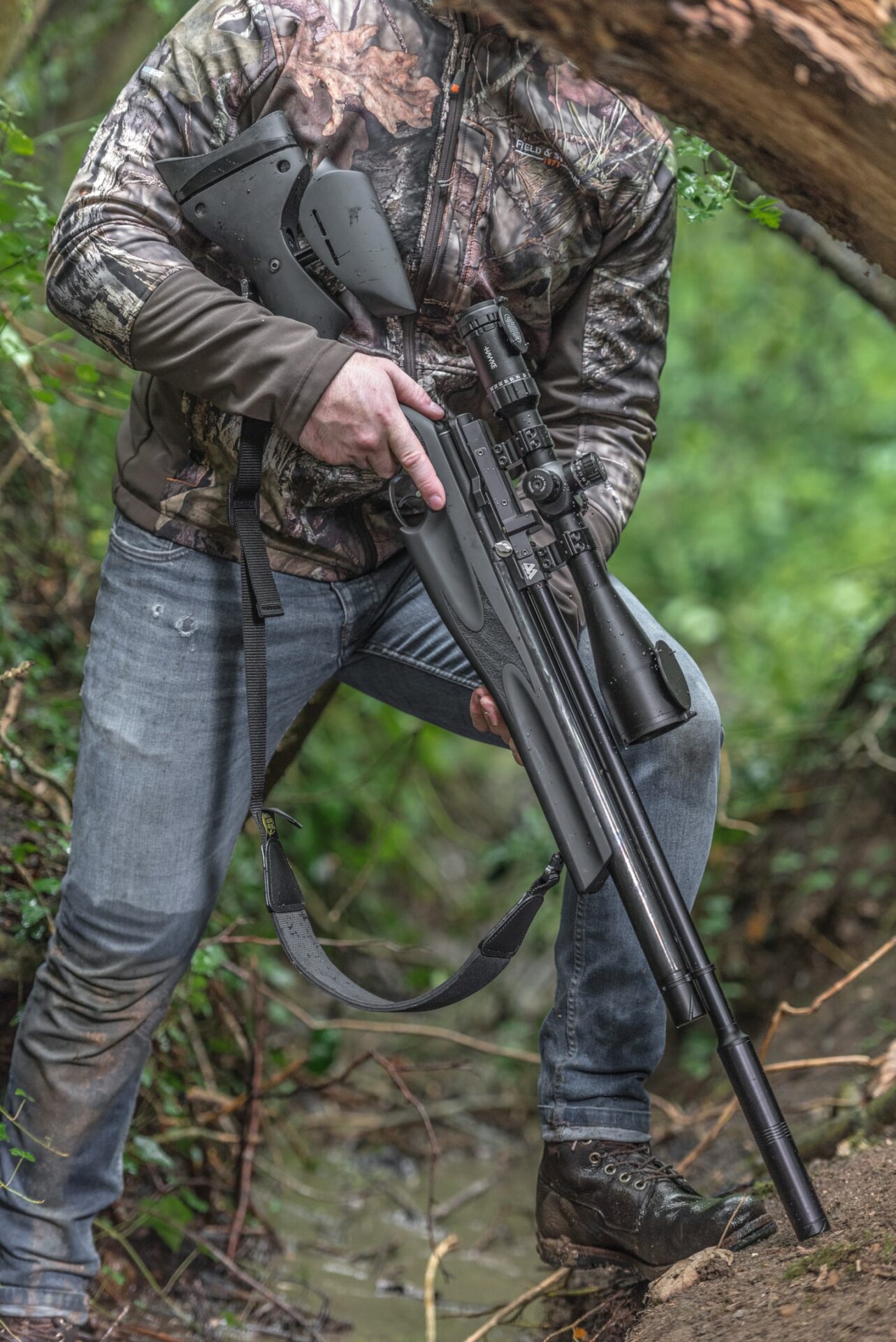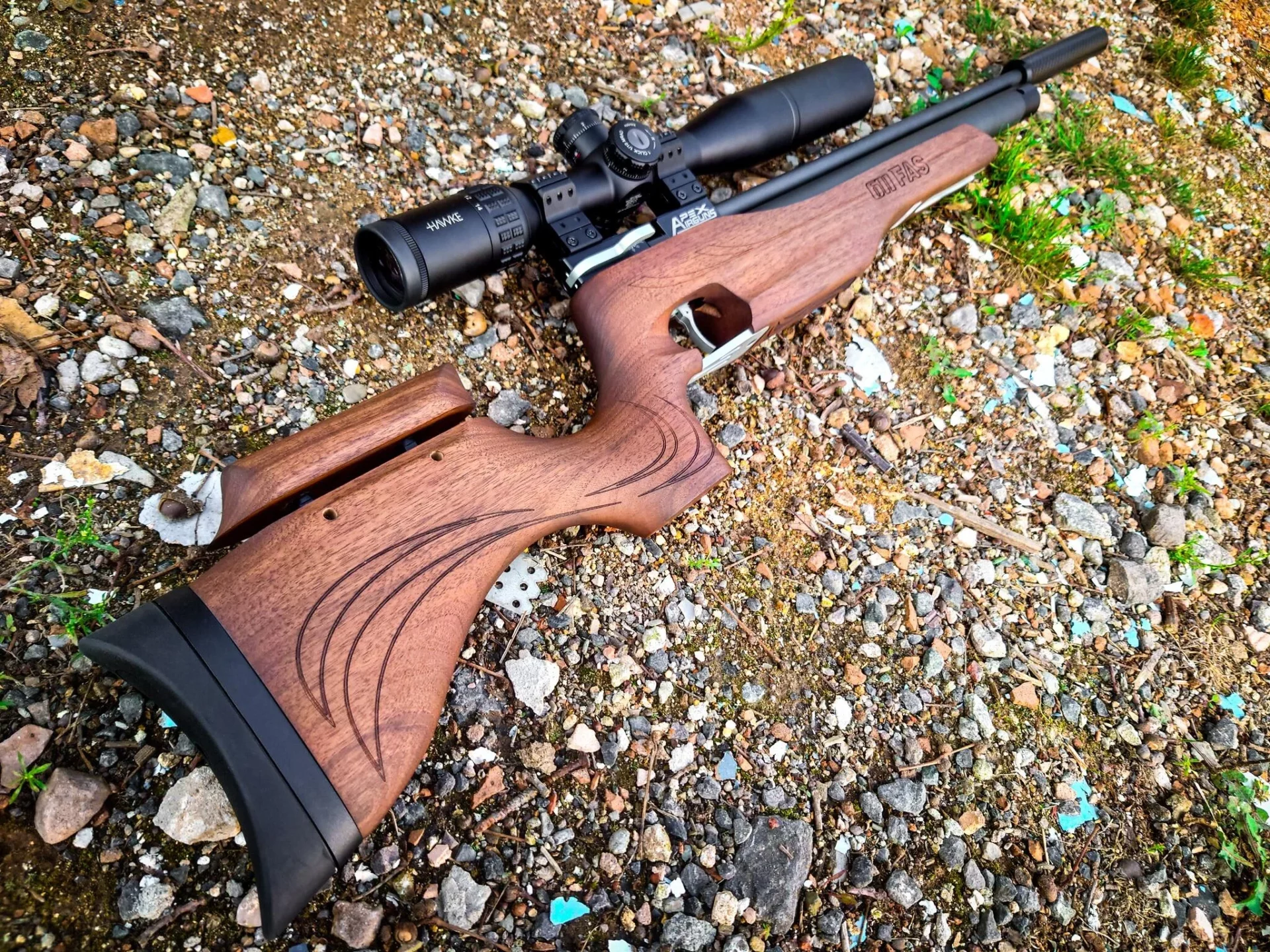A PCP air gun is one of five types of air rifles in the market today.
PCP air guns have become more and more popular and are sought-after due to their versatility, ease, low maintenance, and power at affordable levels.
(For more on the best PCP air rifles on the market, see this post)
In this post, we will take an in-depth look at a PCP rifle, what it is, how it works, its pros and cons, and whether you should buy one at all.
Table of Contents
Where did PCP Come From?
Contrary to common beliefs that PCP rifles are a recent invention, PCP rifles have been around since the mid-1500s.
The first who made the most of them are Austrians.
The Austrians had thousands of PCP guns for their army in the war between them and France.

Their guns were .26 caliber and shot 24 shots-per-minute repeaters in a time when a repeating firearm didn’t even exist.
It gave them a huge advantage over Napoleon’s army who only could shoot three shots per minute due to the loading difficulty of the gunpowder.
After that time, PCP guns continued to be made.
The manufacture of PCP air guns stopped after World War I and they were revived as .177 and .22 caliber around 1980.
PCP air rifle meaning
A PCP air rifle is a type of air gun that uses a pre-filled reservoir of compressed air to propel projectiles. They are known for their consistent power and accuracy, making them popular choices for many airgun enthusiasts.
How does it work?
PCP stands for pre-charged pneumatic, which means that the compressed air is put into the gun prior to it being shot.
Basically, it is an air gun with a hollow tube containing high-pressurized air.
Typically, the air is compressed to 3,000 psi (pounds per square inch), although it can be pressurized more than or less than 3,000 psi.
The pre-pressurized air in a PCP can drain, and with most PCP rifles you will need to refill the air reservoir.

There are multiple ways to fill the air reservoir, such as with hand pumps, scuba tanks, or carbon fiber tanks.
Once the gun is filled to a certain pressure level, it is ready to use.
The firing cycle of PCP happens rather fast.
When you pull the trigger, the firing valve opens and releases compressed air inside the barrel.
The compressed air has nowhere else to go but behind the pellet.
This forces the pellet out of the barrel due to the propellant force of the compressed air.
After that, a small amount of air and pressure in the reservoir is reduced.
How long till you need to fill the gun?
PCP air rifles have a gauge that tells you how much pressure is in the air reservoir so you know when you drop out of the optimum pressure curve.
A lot of gauges have red, green, and yellow color marks on them.
Green is good, yellow is okay, and red means that you need to refill your gun as soon as possible.
Shot capacity
A PCP air gun allows you to have many shots per fill.
Depending on the rifle type, you can have around 20-30 shots before the air reservoir needs to be filled again.
Performance

Similar to a belt curve, a PCP air gun filled with high pressure usually starts with low velocity.
It will then increase in speed before dropping back down again to a low level of velocity.
Therefore, you usually need to shoot several times to find the “sweet spot” so you can adjust the fill to get consistent performance.
If you want to bypass this “sweet spot” testing and get consistent shots immediately, then all you need to do is use your PCP’s air regulator.
An air regulator will work to manage the pressure for the firing valves.
As a result, you have a gun with high pressure but the firing valve always receives the same pressure.
These guns often have a flatter, more consistent trajectory compared to those that don’t have regulators.
An air regulator is usually an addition and will be more expensive.
However, this added expense is worth it.
With an air regulator, you can control the amount of pressure and have consistent shots and power shot after shot.
What types of caliber PCP guns can you shoot?
A PCP gun can shoot .46, .58, or even .72 caliber bullets.
Rossi of American Airgunner TV shoots a helium air rifle that fires a whopping .82 caliber PCP air rifle in Michigan here (yes, a 20 mm air rifle!)
A PCP gun can even handle a higher caliber pellet than a CO2 air gun and that’s because a PCP puts more air behind the projectile whereas a CO2 is temperature dependant.
(For more on the best CO2 air rifle on the market, see this post)
You can’t shoot a bigger caliber with a CO2 gun but a PCP will end up putting a lot of air behind the projectile so you can get very high velocity with a large caliber pellet.
Recoil and Noise
A PCP air gun produces very little recoil and is also very quiet compared to other types of air rifles.
If you are a recoil hater then PCP may be a great way to go.
With its quietness and virtually recoilless performance, a PCP is an excellent choice for younger and novice shooters, although experienced shooters can benefit from it as well.
How about accuracy?
A PCP gun is the most accurate air gun out there.
And PCP is also the easiest air gun to shoot with the most accuracy.
The average shooter can pick up a PCP gun and be just as accurate as a firearm.
With a PCP, you can enjoy accurate shooting as soon as possible without going through any complicated learning process.
Contrarily, if you decide to shoot with a spring-piston gun, then you must accommodate the learning curve that comes with it.
Unlike the spring piston, a PCP requires no holding techniques.

Disadvantages of PCP
The biggest disadvantage of a PCP is its higher expense.
The cost of a PCP can range from as much as several hundred dollars to more than $1,000 dollars for a single gun.
Added to buying filling equipment, some potential buyers have turned away from PCP simply for this reason.
Depending on the type of gun and the type of filling equipment, then purchasing your PCP should be considered an investment.
Additionally, after you buy an air tank and filling equipment for your first gun, you won’t need to repurchase refilling equipment.
The second major disadvantage is that a PCP gun requires support tails: scuba tank or hand pump or carbon fiber tank or air compressor.
Then you have to find a way to fill the tank like finding an air filling station, for example.
Besides, sometimes when traveling by a PCP air gun, the airport authorities may require to look inside the air reservoir which is almost impossible.
For these reasons, having a spring-piston gun on hand would be more convenient.
(For more on the best break barrel air rifle that hits like a champ, see this post)
Conclusion
Although a PCP gun has some disadvantages, it still gains attraction from shooters all over the world.
A PCP gun is a great choice if you want to enjoy the quietness, minimal recoil, high power, multiple-shot capacity, and high accuracy at the beginning of your shooting journey.












































